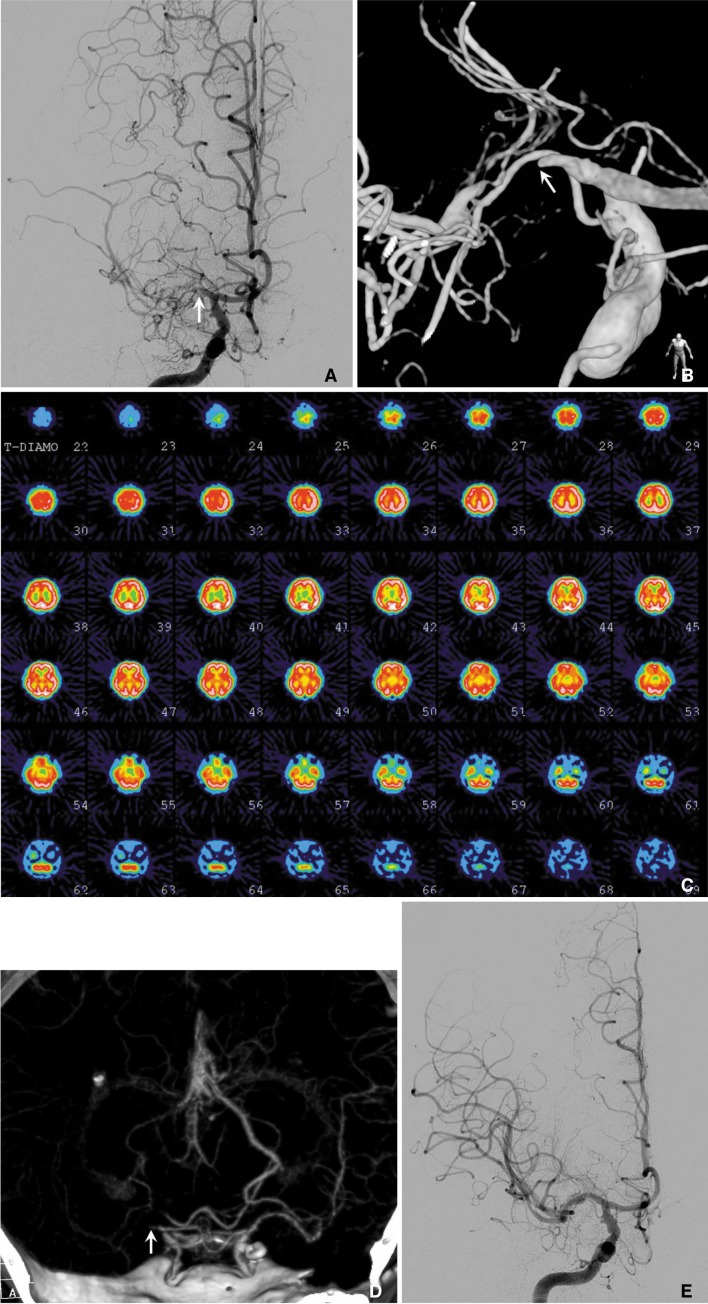Neurointervention.
2012 Sep;7(2):113-116. 10.5469/neuroint.2012.7.2.113.
Late Spontaneous Recanalization of Chronic Middle Cerebral Artery Occlusion
- Affiliations
-
- 1Department of Neurosurgery, Kyung Hee University Hospital at Gangdong, Seoul, Korea. leecy009@hanmail.net
- 2Department of Radiology, Kyung Hee University Hospital at Gangdong, Seoul, Korea.
- 3Department of Neurosurgery, Konyang University Hospital, Daejeon, Korea.
- KMID: 1841098
- DOI: http://doi.org/10.5469/neuroint.2012.7.2.113
Abstract
- Early spontaneous recanalization of the middle cerebral artery in acute ischemic phase artery is not uncommon, whereas the late spontaneous recanalization of chronic occluded artery is a very rare phenomenon and exact incidence and the timing of this event have not been quantified. We present a case in which late spontaneous recanalization of long-lasting middle cerebral artery occlusion occurred in the absence of surgical, endovascular and thrombolytic treatments.
Figure
Cited by 1 articles
-
Endovascular Mechanical Thrombectomy in Basilar Artery Occlusion: Initial Experience
Bum-Soo Park, Chang-Woo Kang, Hyon-Jo Kwon, Seung-Won Choi, Seon-Hwan Kim, Hyeon-Song Koh, Jin-Young Youm, Shi-Hun Song
J Cerebrovasc Endovasc Neurosurg. 2013;15(3):137-144. doi: 10.7461/jcen.2013.15.3.137.
Reference
-
1. Klonaris C, Alexandrou A, Katsargyris A, Liasis N, Bastounis E. Late spontaneous recanalization of acute internal carotid artery occlusion. J Vasc Surg. 2006; 43:844–847. PMID: 16616248.
Article2. Fieschi C, Bozzao L. Transient embolic occlusion of the middle cerebral and internal carotid arteries in cerebral apoplexy. J Neurol Neurosurg Psychiatry. 1969; 32:236–240. PMID: 5795117.
Article3. Kassem-Moussa H, Graffagnino C. Nonocclusion and spontaneous recanalization rates in acute ischemic stroke: a review of cerebral angiography studies. Arch Neurol. 2002; 59:1870–1873. PMID: 12470173.4. Oster JM, Aggarwal P. Spontaneous recanalization of the basilar artery with conservative management months after symptom onset. Neurol Int. 2009; 11. 16. 1:e17. PMID: 21577354.
Article5. Zanette EM, Roberti C, Mancini G, Pozzilli C, Bragoni M, Toni D. Spontaneous middle cerebral artery reperfusion in ischemic stroke. A follow-up study with transcranial Doppler. Stroke. 1995; 26:430–433. PMID: 7886720.6. Rha JH, Saver JL. The impact of recanalization on ischemic stroke outcome: a meta-analysis. Stroke. 2007; 38:967–973. PMID: 17272772.7. Lammie GA, Sandercock PA, Dennis MS. Recently occluded intracranial and extracranial carotid arteries. Relevance of the unstable atherosclerotic plaque. Stroke. 1999; 30:1319–1325. PMID: 10390302.8. Colon GP, Deveikis JP, Dickinson LD. Revascularization of occluded internal carotid arteries by hypertrophied vasa vasorum: report of four cases. Neurosurgery. 1999; 45:634–637. PMID: 10493385.
Article
- Full Text Links
- Actions
-
Cited
- CITED
-
- Close
- Share
- Similar articles
-
- Spontaneous Recanalization from Traumatic Internal Carotid Artery Occlusion
- Clinical and radiological outcomes of mechanical thrombectomy in simultaneous anterior cerebral artery and middle cerebral artery occlusion
- Effects of Spontaneous Recanalization of Left Ventricular Function after Acute Myocardial Infarction
- Carotid Artery Stenting in a Patient with Spontaneous Recanalization of a Proximal Internal Carotid Artery Occlusion: a Case Report
- Intracranial Cerebrovascular Revascularization(Extracranial-Intracranial Arterial Bypass, EIAB)


